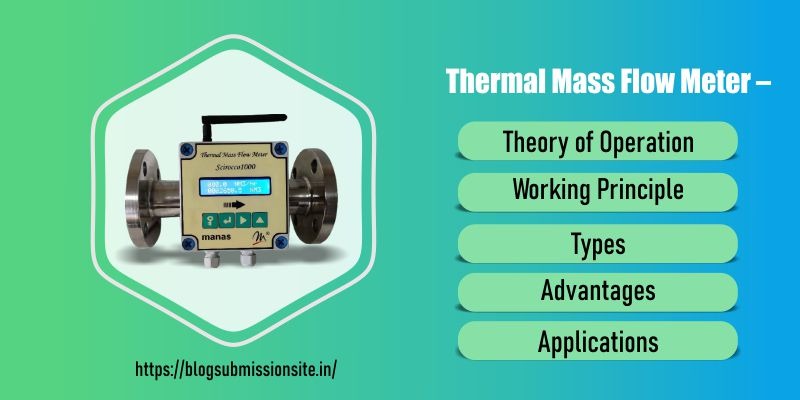Thermal Mass Flow Meter
Thermal mass flow meters, also known as thermal dispersion or immersible mass flow meters are used to measure total mass flow rate of a fluid, primarily gases, flowing through closed conduits. It is a direct mass flow meter with no moving parts.
Theory of Operation
A Thermal Mass Flow Meter contains two temperature sensors for this purpose. Single sensor measures the fluid temperature as a reference. The second sensor is heated and has a constant temperature differential relative to the main sensor. When the flow of air/gas starts heat is taken absent from the warmer sensor. The quantity of heat taken away is having a direct relation with the mass velocity of the fluid. That is how it is a straight mass flow meter.
Being a through mass flow meter, it does not require any pressure and temperature compensation.
Types of Thermal Mass Flow Meter
There are two types of Thermal Mass Flowmeters:
- Thermal Dispersion/Immiscible Type: In case of Thermal dispersion or immersible type, the heat is transferred to the layer of the flowing fluid coming in contact with the heater surface. The convected heat from the surface of the heating element is related to point mass velocity of the fluid.
- Capillary Tube Type: In second type, i.e. capillary type thermal mass flow meter, the heat is transferred to bulk of fluid passing through the small heated capillary tube. Although the principles of operation of both types depend on heat convected, both methods are quite different. Thermal dispersion flow meters are commonly used for general industrial gas flow applications in pipes and ducts and hence are more popular for such industrial applications. The capillary types are primarily used for smaller flows of clean gases or liquids in tubes.
How does a thermal mass flow meter work?
The thermal mass meter measures gas flow based on convective heat transfer. The Sage flow meters are obtainable in either inline flow bodies or insertion-style. In any case, the meter’s probe supplements into a gas stream of a pipe, stack, or duct. Toward the tip of the meter’s probe are dual sensors. These sensors are resistance temperature detectors (RTDs) or resistance thermometers that measure temperature. The RTDs consist of tough reference-grade platinum windings clad in a protective 316 SS or Hastelloy C sheath.
One RTD is heated by an integrated circuit and purposes as the flow sensor, while a second RTD acts as the reference sensor and determines the gas temperature. The Sage branded circuitry maintains a continuous overheat between the flow and reference sensors. As gas flows by the heated RTD, drifting gas molecules transport heat away from it, and as aoutcome, the sensor cools, and the energy escapes. The circuit balance disrupts, and the temperature change (ΔT) between the heated RTD and the reference RTD changes. The circuit restores the lost energy within aadditional by heating the flow sensor to adjust the overheat temperature.
The electrical power mandatory to sustain this overheat denotes the mass flow signal.
What are the advantages of thermal mass flow meters?
- Thermal flow meters have no moving parts, reducing maintenance and permitting the use in demanding application areas, including saturated gas.
- Gas mass meters calculate mass flow rather than volumetric flow. They do not require temperature or pressure alteration, so there is no additional expense for purchasing and installing other equipment.
- Thermal flow meters provide excellent accuracy and repeatability over a wide range of flow rates.
- Thermal flow meters can degree flow in large pipes.
- Thermal mass flow meters are by far the most popular instruments for determining mass flow of low gas flow. Since the introduction of these instruments in the mid-1970s, they have undergone considerable growth, from analogue to digital, from low flow to higher flow, from applications in laboratories and machines to industrial environments and even hazardous areas. There is a suitable thermal mass flow meter for almost each low-flow gas application. Other measurement principles that can be used for low-flow gas uses are Coriolis flow measurement and differential pressure measurement.
What are the Applications of thermal mass flow meters?
- Thermal mass flow meter is used in a variety of gas flow applications such as-
- Compressed air/ Gas Consumption measurement
- Gas measurement at very low-pressure flowing conditions
- Fuel Gas like CNG consumption measurement and control
- Automobile gas engine testing
- Industrial oxygen flow measurement and control
- Furnace and burner control
- Biogas measurement in digester biogas digester systems





